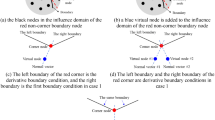Abstract
The successive sub〈stitution (SS) method is a suitable approach to solving the transient distributed-parameter model for heat exchangers. However, this method must be enhanced because its convergence heavily depends on the iterative initial pressure. When the iterative initial pressure is improperly assigned, the calculated flow rates become negative values, causing the state parameters to exhibit negative values as well. Therefore, a predictor-corrector algorithm (PCA) is proposed to improve the convergence of the SS method. A predictor is developed to determine an appropriate iterative initial pressure. Total fluid mass is adopted as the convergence criterion of pressure iteration instead of outlet flow rate as is done in the SS method. Convergence analysis and case study of the PCA and SS method are conducted, which show that the PCA has better convergence than the SS method under the same working conditions.
Similar content being viewed by others
References
Wedekind G L, Stoecker W F. Transient response of the mixturevapor transition point in horizontal evaporating flow, ASHRAE Transactions, 1966, 72(II): IV.2.1–IV.2.15
Chi J, Didion D. A simulation model of the transient performance of a heat pump, International Journal of Refrigeration, 1982, 5(3): 176–184
Fu L, Ding G L, Zhang C L. Dynamic simulation of air-to-water dual-mode heat pump with screw compressor. Applied Thermal Engineering, 2003, 23(13): 1629–1645
Pettit N B O L, Willatzen M, Plong-Sørensen L. A general dynamic simulation model for evaporators and condensers in refrigeration part II: simulation and control of an evaporator. International Journal of Refrigeration, 1998, 21(5): 404–414
Zhang W J, Zhang C L. A generalized moving-boundary model for transient simulation of dry-expansion evaporators under larger disturbances. International Journal of Refrigeration, 2006, 29(7): 1119–1127
Nyers J, Stoyan G. A dynamic model adequate for controlling the evaporator of a heat pump. International Journal of Refrigeration, 1994, 17(2): 101–108
Jia X, Tso C P, Chia P K, Jolly P. A distributed model for prediction of the transient response of an evaporator. International Journal of Refrigeration, 1995, 18(5): 336–342
Aprea C, Renno C. An air cooled tune-fin evaporator model for an expansion valve control law. Mathematical and Computer Modeling, 1999, 30(7–8): 135–146
Wang C C. A numerical method for thermally non-equilibrium condensing flow in a double-pipe condenser. Applied Thermal Engineering, 1997, 17(7): 647–660
Wang H, Touber S. Distributed and non-steady-state modeling of an air cooler. International Journal of Refrigeration, 1991, 14(2): 98–111
Jia X, Tso C P, Jolly P, Wong Y W. Distributed steady and dynamic modeling of dry-expansion evaporators. International Journal of Refrigeration, 1999, 22(2): 126–136
Tso C P, Cheng Y C, Lai A C K. Dynamic behavior of a direct expansion evaporator under frosting condition Part I. Distributed model. International Journal of Refrigeration, 2006, 29(4): 611–623
Koury R N N, Machado L, Ismail K A R. Numerical simulation of a variable speed refrigeration system. International Journal of Refrigeration, 2001, 24(2): 192–200
Mithraratne P, Wijeysundera N E, Bong T Y. Dynamic simulation of a thermostatically controlled counter-flow evaporator. International Journal of Refrigeration, 2000, 23(3): 174–189
Mithraratne P, Wijeysundera N E. An experimental and numerical study of the dynamic behavior of a counter-flow evaporator. International Journal of Refrigeration, 2001, 24(6): 554–565
Jiang H B, Radermacher R. A distributed model of a space heat pump under transient conditions. International Journal of Energy Research, 2003, 27(2): 145–160
Rice C K. The effect of void fraction correlation and heat flux assumption on refrigerant charge inventory predictors. ASHRAE Transactions, 1987, 93(part 1): 341–367
Ding G L. Recent developments in simulation techniques for vapour-compression refrigeration systems. International Journal of Refrigeration, 2007, 30(7): 1119–1133
Ding G L. Dynamic simulation and optimization of small refrigeration equipments. Dissertation for the Doctoral Degree. Shanghai: Shanghai Jiao Tong University, 1993, 45–67
Gungor K E, Winterton, R H S. A general correlation for flow boiling in tubes and annuli. International Journal of Heat Mass Transfer, 1986, 29(3): 351–358
Ding G L, Wu Z G, Liu J, Inagaki T, Wang K J, Fukaya M. An implicit curve-fitting method for fast calculation of thermal properties of pure and mixed refrigerants. International Journal of Refrigeration, 2005, 28(6): 921–932
Author information
Authors and Affiliations
Corresponding author
Rights and permissions
About this article
Cite this article
Zhang, P., Ding, G. Predictor-corrector algorithm for solving quasi-separated-flow and transient distributed-parameter model for heat exchangers. Front. Energy Power Eng. China 4, 535–541 (2010). https://doi.org/10.1007/s11708-010-0113-y
Received:
Accepted:
Published:
Issue Date:
DOI: https://doi.org/10.1007/s11708-010-0113-y




